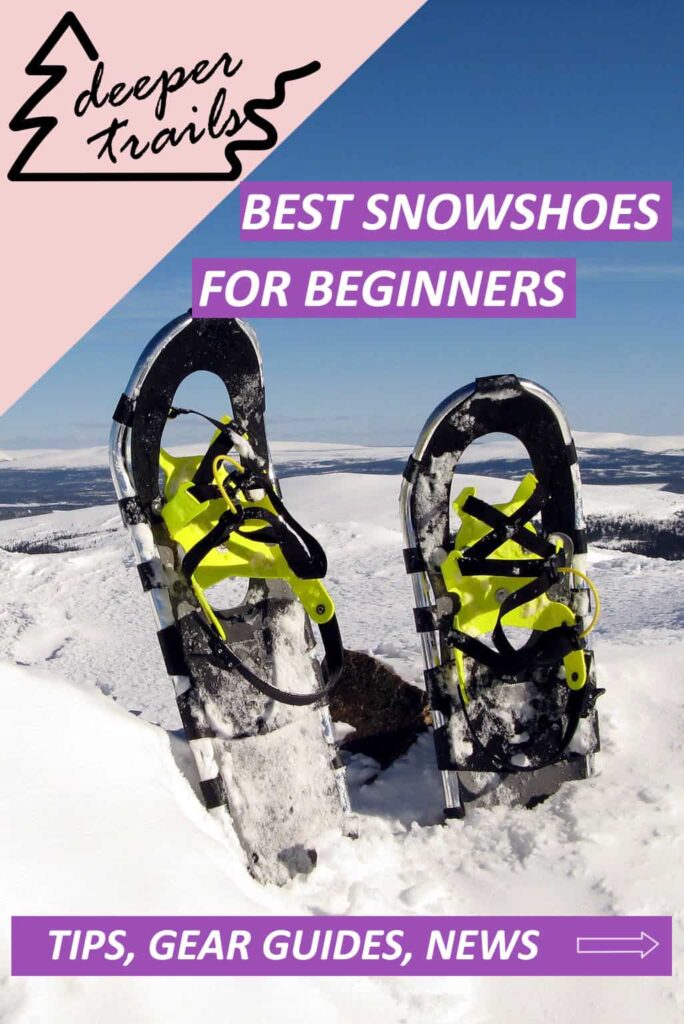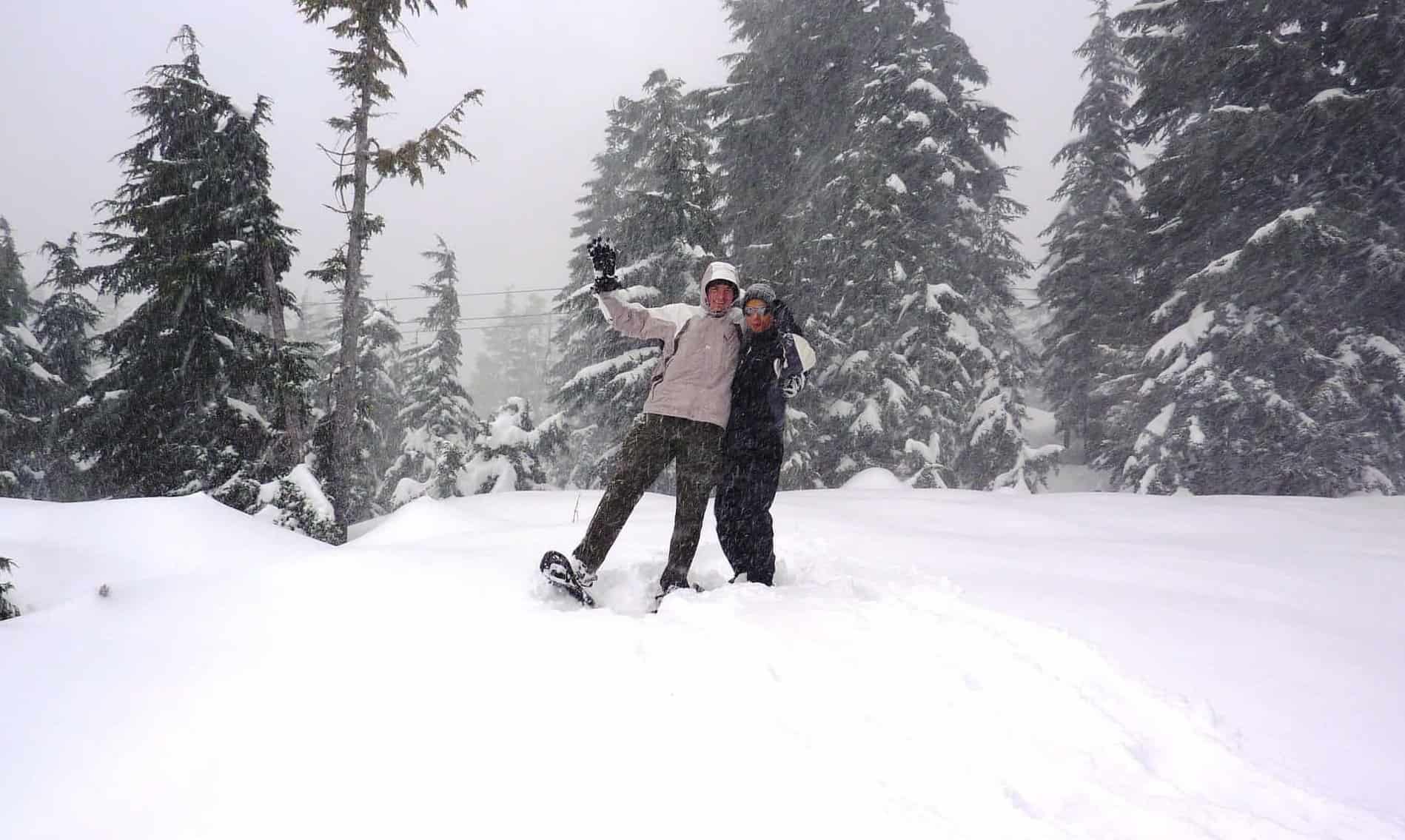Last updated on October 25th, 2022 at 03:04 pm
Snowshoeing can be a great remedy for the winter blues. For beginners the gear required can be intimidating. Afterall the shoe itself is an essential part of the activity. For this reason, we thought it would be helpful to provide a list of what we found are the 5 best snowshoes for beginners.
The Best Snowshoes for Beginners Are...
We provide much more detail on our top three further down in this post, as well as a comparison table of all the snowshoes we researched. However, we found these options to stand out as our top three snowshoes for beginners:
The Best Overall: MSR Evo Trail 22”
Second Best: Chinook Trekker 25”
Honorable Mention: Yukon Charlies Sherpa
Any of these three will get you off on the right foot, literally. Read through the rest of this post to get more specifics on all the snowshoes we researched.
Table of Snowshoes for Beginners
While we outline our favorite three snowshoes for beginners above, there are other great options out there. In fact, some of these options even come with a bag and trekking poles. So, below we provide a comparison table of the various snowshoe options for quick reference.
| Picture | Name / Link | Carrying Capacity |
|---|---|---|
 |
MSR Evo Trail | 180 lbs / pair |
 |
Chinook Trekker | 130-210 lb / pair |
 |
Yukon Charlies Sherpa | Up to 300 lb / pair |
 |
Flashtek Package | 155 lbs / pair |
 |
Red Feather Recreational | 150 - 220 lbs / pair |
Our Favorite Snowshoes for Beginners: MSR Evo 22" Trail Hiking Snowshoes
First, the MSR Evo Trail 22” is our favorite for beginners.
In fact, we found these to be the best combination of ease of use, durability, and weight.
Lightweight with Great Float
furthermore, the Evo Trail 22” snowshoes are 8″ x 22”, so they offer a great surface area for float.
Plus, the Evo Trail 22″ weighs in at around 3.56 lbs as a pair.
In fact, this is one of the lightest, which means your legs won’t be dragging on your snow hike.
Moreover, the Evo Trail can support up to 180 lbs. as a pair.
RELATED: Best Boots for Snowshoeing
Freeze-Proof Rubber Bindings
Additionally, the Evo Trail features rubber binding straps.
As a result, these bindings won’t freeze, which will make your life much easier.
Furthermore, this is the part of the snowshoe you will have to deal with the most. Plus, this binding style is easy to figure out and made of high-quality material that is unlikely to break with normal wear and tear.
Moreover, the straps are also large enough that you can easily adjust them while wearing gloves.
We love how little metal is used in the Evo Trail’s binding construction, which is a big reason why these are at the top of the list.
Durable Materials
Finally, aside from the bindings, the rest of the Evo Trail are made with the usual MSR quality materials, balancing durability and weight.
We can personally vouch for these snowshoes, and find that this model serves beginners just as well as the pros.
Furthermore, the MSR brand is made in the USA.
Plus, the Evo Trail features a durable deck free of weak aluminum and complete with steel traction rails and crampons.
Pros and Cons of the MSR Evo 22" Trail Hiking Snowshoes
Evo Trail Snowshoes PROS
- Freeze-proof bindings
- Supports up to 180 lbs
- Very durable
- Great float
- Excellent traction
- Made in the USA
Evo Trail Snowshoe CONS
- Cost
- Limited color options
Our Runner-Up Snowshoes: Chinook Trekker Snowshoes, 25”
Next, the Chinook 80002 Trekker Snowshoes 25″ are a fantastic choice for the budget-conscious. Furthermore, the Chinook combines a relatively low cost with a design that allows you to get out on the snow and learn the sport easily.
Lightweight and Large Weight Capacity
Firstly, the Chinook Trekkers are 8.3″ x 25”, weigh 4.3 lbs as a pair, and can support weights from 130 lbs. up to 210 lbs. a pair.
Easy to Use
RELATED: Best Snowshoes for Running
Firstly, the Cinook Trekker is easy to use.
For instance, just drop your boot in and ratchet down as tightly as you need.
Furthermore, we found the Trekker to give a snug fit and a tight connection that keeps you moving rather than constantly fiddling with your gear.
Complete with Accessories
Finally, the Trekker also comes with a great storage bag.
Again, that might not seem like a big deal. But it matters for this reason: the bottoms of snowshoes have spikes that help you move through the snow and ice.
These crampons and spikes can be a pain when not in use. In fact, the bag helps protect your other gear in the car and aids in storage during the off season.
Pros and Cons of the Chinook Trekker Snowshoes, 25”
Chinook 80002 Snowshoes PROS
- Budget friendly
- Bindings that will make snowboarders feel at home
- Light enough to keep the leg burn to a minimum
Chinook 80002 Snowshoe CONS
- Bindings could freeze-up
- Constructed from less durable materials than other options
Third Best: Yukon Charlies Sherpa Snowshoe
Finally, the Yukon Charlies Sherpa snowshoes perfect for beginners and the budget-conscious buyer.
Furthermore, the Sherpa can hold quite a heavy load and features sturdy reliable bindings.
Can Carry Heavy Loads
Firstly, the biggest selling point for these snowshoes is that they are burly.
For instance, the Sherpa measures 10″ x 36” and is capable of carrying up to 300 lbs. as a pair.
Additionally, this means they are the best choice for bigger folks or those who are also considering carrying heavy packs on snowshoeing trips.
In fact, it’s not uncommon for packs to be upwards of 60 extra pounds. And the extra length and width of the Sherpa are capable of keeping you afloat and upright.
RELATED: Best Snowshoes for Kids
Quality Construction
Furthermore, the Sherpa’s materials are durable and the design is user friendly.
In fact, the Sherpa features a Quick Click II ratcheting binding system that we found to be very easy to use, even with gloves.
Additionally, the Sherpa’s frame is made of lightweight aluminum with a very durably polyethylene deck.
Finally, with all of these quality features, the Sherpa is still only 5 lbs. as a pair.
Quality Construction
Finally, with all of these quality features, the Sherpa is still only 5 lbs. as a pair.
Not only does this fair well for fighting fatigue, these snowshoes are easy to carry on the outide of your pack.
Pros and Cons of the Yukon Charlies Sherpa Snowshoe
Yukon Charlies Sherpa PROS
- Quality materials
- Budget-friendly
- Great float
- Supports up to 300 lbs.
- Easy to use
Yukon Charlies Sherpa CONS
- Aluminum frame can bend on obstacles
How a Beginner Should Choose the Right Snowshoes
As a beginner, you don’t have to break the bank or take a lesson to get started with snowshoeing. In fact, there are a ton of relatively inexpensive options out there. However, for those new to the sport, choose a pair that:
- Fits your trip. Firstly, consider the kind of trips you want to take on. For short day trips, which is probably the best idea for beginners, the MSR Evo Trails or the Chinook Trekkers will be great. However, for trips that require you to carry a heavy backpack, consider the a larger shoe with higher weight capacity.
- Are easy to repair. Furthermore, you want to carefully consider how you would repair the snowshoe if it breaks while you are on the trail. For instance, the bindings are the most likely part to fail. The MSR Evo Trails would probably be the easiest to repair because you could just carry a piece of webbing or even rope to replace or reinforce a part of the binding straps. So, before you buy a pair of snowshoes, have at least a rough idea how you would repair it on the trail.
- Easy to use. Not only do you want an easy to wear snowshoe, you’ll appreciate freeze-proof bindings and clips while wearing gloves.
- Are made of durable materials. Snowshoes without cloth decks and with less parts will remain in good condition for years to come.
- Are lightweight. Finally, lightweight is always better unless you really need it or you prefer durability over aluminum for instance.
What size snowshoe do you need?
Choosing the right size snowshoe is all about picking a product that can support the weight you need it to.
Furthermore, don’t exceed the manufacturer’s recommendations here. If you do, you are at risk for breaking your gear or sinking in the snow, both of which will make your trek almost impossible.
Also, keep in mind that most of these products do come in different sizes. The data we have listed in our table above is generally for 22” snowshoes.
RELATED: Best Gaiters for Snowshoeing | Dry Ankles
Additionally, each of our recommendations will fit most average shoes sizes. However, if you have extra small or large feet (less than men’s size 4 or more than 15), you may need to do a little extra research to choose a product that will accommodate you.
What kind of shoes do you wear with snowshoes?
Additionally, wearing the right footwear is crucial to enjoying your snowshoeing experience. Whatever you wear on your feet needs to meet the following requirements:
- They are comfortable enough and fit well enough for you to do vigorous exercise while wearing them.
- They will keep your feet warm and dry. Usually, this means you should have something waterproof.
It would be a shame for your foray into snowshoeing to be ruined by cold, uncomfortable or wet footwear.
So, before you buy snowshoes, decide what shoes you will wear.
In fact, great options include snowboarding boots, general use snow boots, waterproof hiking boots, or, for some hearty souls, waterproof trail running shoes paired with waterproof gaiters.
Don’t Hesitate to Get on The Snow
Perhaps the best thing about snowshoeing is the simplicity involved. Plus, it’s great exercise that helps you explore quiet trails during the dead-of-winter. With just a little gear and planning, you can get outside and enjoy the sport right away.
For your first time, make sure you have some poles and anything else you would usually take on a hike, including water, snacks and a little extra clothing. And then just get out there and enjoy the snow.
RELATED POSTS:



Comments are closed.